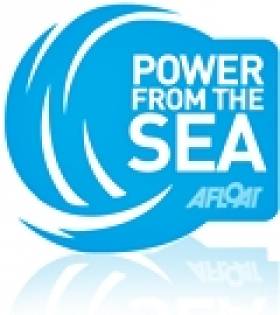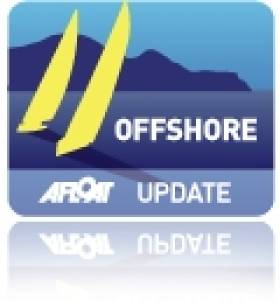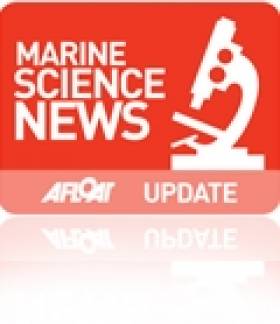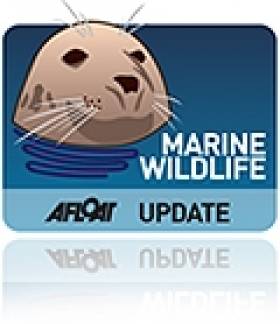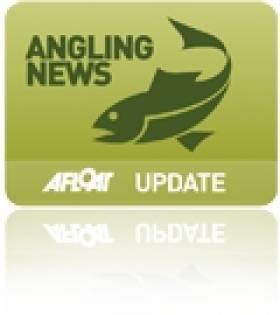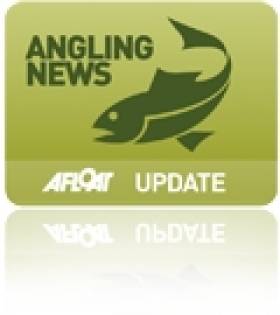Displaying items by tag: Atlantic
Replacement of Crucial Eagle Island Atlantic Lighthouse by Helicopter Lift
#lighthouse – A challenging lighthouse redevelopment project has been completed on one of the most testing sites on the Irish Atlantic coast. The Commissioners of Irish Lights (CIL) has completed a re-construction and modernisation project at Eagle Island Lighthouse in Co. Mayo – a landmark lighthouse safeguarding Ireland's north-westcoast. The new light is being commissioned today.
This demanding project on Eagle Island consisted of the replacement of the entire upper part of the lighthousestructure using a helicopter. This is one of the mostchallenging construction projects undertaken by CIL in recent years.
Captain Robert McCabe, Director of the Operations and Navigation Services with CIL stated "Eagle Island lighthouse stands 220 feet above the Atlantic ocean, yetover the years waves from winter storms have damaged buildings and equipment in the walled lighthouse compound. Eagle Island lighthouse must provide a reliable and effective aid to navigation in extreme conditions because it is, at these times, when marinersmost require CIL aids. The new light on Eagle Island will provide a high quality, highly reliable 18 mile LED light and, for the first time, an automatic identification system. The solar battery system will remove the requirement for diesel generation with consequent environmental benefits and maintenance savings."
The Commissioners of Irish Lights (CIL) is actively involved in consolidating its coastal infrastructure which is the latest chapter in technology change that CIL is currently implementing; first came automation, then solarisation and now consolidation. The overriding purpose of consolidation is to provide a low-maintenance, low-energy, and low-cost Aids to Navigation service around the Irish Coast.
Eagle Island's unique location saw the establishment oftwo lighthouses on the island, both completed in 1835.Because of its close proximity to the continental shelfEagle Island experiences unusually large waves and over the years the lanterns have regularly been damaged by waves and water-borne rocks.
Due to these ferocious conditions, a huge storm wall was constructed surrounding the lighthouses. This wall was destroyed by the sea, reinforced and eventually abandoned after a particularly large storm in 1894 when it was decided to abandon the lower lighthouse.
The lighthouse keepers were withdrawn with the automation of the current lighthouse in 1988.
After almost 200 years of guiding mariners to safety, the lantern room and domed roof of the lighthouse tower had reached the end of their working life. The old lighthouse dome, the lantern room, the large glass lens and the bath of mercury in which the lens rotated were all removed. They were replaced with a stainless steel structuredesigned by CIL to withstand the aggressive and relentless marine environment.
This structure was manufactured by Shortt Stainless Steel in Limerick which incorporates a new roof, a guarded access platform and light pedestals. The roof also supports new waterproof and weather resistant flashing LED (light emitting diode) lights.
A temporary works system was also designed to access the previous dome for demolition works. This platformincorporated the means to manhandle heavy equipmentand the helicopter deck on which to land the new dome.Constructing all of this on top of the lighthouse tower was extremely challenging.
Commenting on the success of this unique construction challenge, Captain Robert McCabe of CIL stated "The CIL team who delivered this complex project have demonstrated exceptional engineering, planning and construction skills and made a positive contribution to safety at sea and the marine environment."
Exploration Licences Granted in Atlantic Margin Licensing Round
Minister for Natural Resources, Fergus O'Dowd, today announced the timing and outline of the next Atlantic Margin Oil and Gas Exploration Licensing Round. The full detail of the Round will be announced after a review of oil and gas fiscal terms is complete in early 2014.
The Round is scheduled to open in April 2014 and will close in September 2015. It will include all of Ireland's major Atlantic basins, and the form of licence on offer will be a two year licensing option.
Speaking at the Atlantic Ireland Conference in Dublin this morning, Minister O'Dowd highlighted the increased interest in the oil and gas potential of the Irish Offshore.
"It is a fact that Ireland competes for mobile exploration investment in the same way it competes for Foreign Direct Investment in already established onshore sectors," said Minister O'Dowd.
"The Government's strategy for the exploitation of the State's natural hydrocarbon resources aims to maximise the level of exploration activity and increase the level of production activity, while ensuring a fair return to the State from these activities.
"It is important then that the State provides suitable opportunities for international investors and provides the right environment to encourage industry to take the risk associated with investing in exploration."
The Minister indicated that the details of the forthcoming Atlantic Margin Licensing Round would not be finalised until after a review of oil and gas fiscal terms is complete in early 2014.
"Minister Rabbitte and I have announced that we are seeking further independent expert advice on the "fitness-for-purpose" of Ireland's fiscal terms.
"Such expert advice will focus on what level of fiscal gain is achievable for the State and its citizens and, also on the mechanisms best suited to produce such a gain.
"It is intended to bring consideration of this matter to a conclusion in the coming months. This will ensure that the next licensing round can be launched against a backdrop of regulatory certainty and encourage new investment in exploration."
The Minister welcomed the recent entry into the Irish Offshore of the large independent oil companies Cairn, Kosmos and Woodside.
He noted that applications had been received by his Department to convert 12 of the 13 Licensing Options issued under the 2011 Atlantic Margin Licensing Round to full Frontier Exploration Licences, and that this would result in a step change in exploration activity levels in the coming years.
The Minister commented that "the 2011 Atlantic Licensing Round has delivered on its objectives and the challenge for us now is to build on that achievement".
In advancing the September 2015 close for the next Licensing Round the Minister stated that "in deciding on the timing of the round, I recognise the value in allowing sufficient time for oil companies to devote resources and commence work on evaluating data, so that they can make strong applications."
The Minister also indicated that the conditions of the Licensing Round will seek to address the fact that in the 2011 Licensing Round there were large areas in the Irish Offshore in respect of which no applications were received.
Noting that there had been no new commercial discoveries in the Irish Offshore since the discovery of the Corrib gas field in 1996, he stated that "whilst growth in exploration activity increases the chance of commercial discoveries being made it brings no guarantees. What we are witnessing in our offshore is positive and there is a clear forward momentum.
"The Government's intention is that momentum should be maintained, with the ultimate aim of ensuring that the true potential of our indigenous oil and gas resources will be realised for the benefit of our people".
Francis Joyon has shattered the North Atlantic record: 5 days, 2 hours, 56 minutes and 10 seconds or in other words a time that is 16 hours, 34 minutes and 30 seconds less than the previous record set by Thomas Coville in 2008.
Over the final stretch, Francis Joyon came very close to beating his own outright distance record over 24 hours (666.2 miles) and this enabled the Breton skipper to make important gains over the second half of the crossing, in spite of sailing some distance away from the Great Circle Route.
Marine Notice: 2D Seismic Survey On Continental Shelf
#MarineNotice - The latest Marine Notice from the Department of Transport, Tourism and Sport (DTTAS) advises that ENI Ireland BV, in conjunction with DCENR/PAD, is scheduled to conduct a 2D seismic survey in the Atlantic waters of the Irish Designated Continental Shelf (as defined under Part VI of UNCLOS).
The planned start of the survey is early June and, weather permitting, will continue until mid-October 2013. The seismic acquisition will be carried out by the seismic vessel M/V BGP Explorer (Call sign HP4919) and will be accompanied at all times by guard vessel M/V South (Call sign PJKE).
This proposed survey consists of 18,000km of a full fold 2D seismic survey in offshore waters beyond the 12-nautical-mile limit, and extends into international (high seas) waters.
The M/V BGP Explorer will travel at a speed of 4-5 knots, towing a single solid 10km streamer located approximately 10m below the surface. Both work vessels will be listening on VHF Channel 16 throughout the project.
All vessels, particularly those engaged in fishing, are requested to give the M/V BGP Explorer and the M/V South a wide berth and keep a sharp lookout in the relevant areas.
For co-ordinates of the seismic survey areas see Marine Notice No 25 of 2013, a PDF of which is available to read or download HERE.
The European Union, The United States and Canada today agreed to join forces on Atlantic Ocean Research. The goal is to better understand the Atlantic Ocean and promote the sustainable management of its resources. The Agreement aims to connect the ocean observation efforts of the three partners. The work will also study the interplay of the Atlantic Ocean with the Arctic Ocean, particularly in relation to climate change. The EU and its Member States alone invest nearly two billion euro on marine and maritime research each year. The 'Galway Statement on Atlantic Ocean Cooperation' was signed today at a high level conference at the Irish Marine Institute in Galway.
European Commissioner for Research, Innovation and Science, Máire Geoghegan-Quinn, said: "The enormous economic potential of the Atlantic remains largely untapped. We probably know more about the surface of the Moon and Mars than we do about the deep sea floor. This alliance can make a big contribution to meeting challenges such as climate change and food security."
European Commissioner for Maritime Affairs and Fisheries, Maria Damanaki, said: "Today's agreement fully supports the Maritime Strategy for the Atlantic we put forward this month. While the initiative is of particular interest for the EU's five Atlantic states, it is open to researchers from all over Europe and beyond. The knowledge gained will be of benefit to all."
The agreement recognises that Atlantic research will in many areas be more effective if coordinated on a transatlantic basis. Areas for potential collaboration under the agreement include: an Atlantic Ocean observation and forecasting system; mapping critical areas of the Atlantic seafloor; identifying and recommending future research and ocean literacy and awareness initiatives.
Taoiseach, Mr. Enda Kenny, T.D., said: "Today marks a new political and policy awareness of the ocean's potential to create sustainable jobs and growth. Such awareness also provides broader societal benefits of understanding major environmental changes and associated risks. It was a major priority of the Irish Presidency to support the achievement of an Atlantic Ocean research alliance and I welcome the signing of the Galway Statement by the European Commission, the United States and Canada here at the Marine Institute today. The delivery of a Maritime Strategy for the Atlantic was also a priority of Ireland and I congratulate all those involved in the launch of the Action Plan to revitalise the marine and maritime economy in the Atlantic Ocean Area."
"The enormous economic potential of the Atlantic remains largely untapped"
The Atlantic Action Plan aims to show how the EU's Atlantic Member States, their regions and the Commission can help create sustainable growth in coastal regions and drive forward the "blue economy", which has the potential to provide 7 million jobs in Europe by 2020.
Mr. Simon Coveney, T.D., Minister for Agriculture, Food and the Marine said: "Ireland has a significant role to play in the implementation of the Atlantic Area Action plan and will also derive many benefits from it. The Government's 'Integrated Marine Plan for Ireland – Harnessing Our Ocean Wealth' is rooted in the role the oceans can play in our economic recovery with a goal of significantly increasing the turnover of Ireland's "Blue Economy" to over €6.4Billion by 2020 and doubling the GDP contribution by 2030 (to 2.4%)."
The Taoiseach, as Irish Presidency of the Council of the European Union, in association with Ms Maria Damanaki, Commissioner for Maritime Affairs and Fisheries, and Ms Máire Geoghegan-Quinn, Commissioner for Research, Innovation and Science and Minister for Agriculture and the Marine, Simon Coveney, is holding a meeting on Friday at the Marine Institute in Oranmore, Galway: The Atlantic – a Shared Resource.
The Political Leaders will discuss research and innovation requirements needed between now and 2020 to implement the Atlantic Area Action Plan to drive the "blue economy".
An outline of Horizon 2020 funding initiatives that will support the implementation of the Action Plan and transatlantic scientific collaboration. Ireland's contribution to the delivery of the action plan during the Irish Presidency and its implementation to 2020 and a joint declaration on an Atlantic research partnership between the European Commission, the USA and Canada.
#MarineWildlife - A gray whale has been sighted many thousands of miles from its usual Pacific swimming grounds in the South Atlantic.
As Pádraig Whooley writes on the Irish Whale and Dolphin Group (IWDG) website, the whale was spotted in the last week in Walvis Bay, Namibia - only the second ever confirmed sighting of the marine species in the Atlantic Ocean, and the first south of the equator, since records began.
Previously a solitary gray whale was tracked in the Mediterranean in May 2010 from the coast of Israel to Barcelona in north-eastern Spain.
That was the first time a gray whale had been seen anywhere east of the Pacific Ocean following the presumed extinction of the Atlantic gray whale in the 17th century.
Whooley calls the latest sighting "a fascinating discovery" and says it "points strongly towards a dramatic shift in distribution facilitated by climate change.
"This is a timely reminder that we should never assume to know what species occur in our local waters, especially when this species seems to have literally come back from the dead."
Marine Notice: New Seismic Survey Of Continental Shelf
#MarineNotice - The latest Marine Notice from the Department of Transport, Tourism and Sport advises mariners that ENI Ireland BV is scheduled to conduct a 2D seismic survey in the Atlantic waters of the Irish Designated Continental Shelf.
The planned start of the survey is mid-April 2013 and, weather permitting, will continue until mid-October 2013.
The proposed survey consists of 18,000km of a full-fold 2D seismic survey in offshore waters beyond the 12-nautical-mile limit, and extends into international (high seas) waters.
The seismic acquisition will be carried out by the seismic vessel M/V BGP Explorer (Call sign HP4919), which will be accompanied at all times by guard vessel M/V Alk Explorer (Call sign HO2639). In addition, M/V De Vrouw Marie (Call sign HP9974) will act as a supply vessel for the re-supply of materials.
M/V BGP Explorer will tow a single solid 10km streamer. The vessel will travel at 4–5 knots and the streamer will be located approximately 10 metres below the surface. All vessels will be listening on VHF Channel 16 throughout the project.
The notice requests all vessels, particularly those engaged in fishing, to give the M/V BGP Explorer, the M/V Alk Explorer and the supply vessel a wide berth, and keep a sharp lookout in the relevant areas.
Details of co-ordinates for the seismic survey are included in Marine Notice No 13 of 2013, a PDF of which is available to read or download HERE.
Notice of this latest seismic survey comes after the news that the European Commission has sought an explanation from the Government over why it has not conducted environmental impact assessments for such operations in Irish waters, which are a designated whale and dolphin sanctuary.
Meanwhile, another recent Marine Notice advises passenger ship operators of the requirements for vessels engaged in the tendering of passengers between ship and shore.
Full details on the relevant provisions of the Merchant Shipping Acts are included in Marine Notice No 12 of 2013 available HERE.
Major Conference on Atlantic Salmon Stocking Announced
#Angling - The Atlantic Salmon Trust will team with IBIS (Integrated Aquatic Resources Management Between Ireland, Northern Ireland and Scotland) to host a major conference at the Marriott Hotel in Glasgow on 27-28 November 2013.
Leading speakers will be invited to discuss all aspects of salmon stocking at the conference, titled 'Boosting salmon numbers: is stocking the answer or the problem?'
Over two days, the conference will examine in depth the potential role of stocking in restoring, sustaining and enhancing salmon populations and fisheries.
In a statement, IBIS said: "We are bringing together experts on salmon science and management - including those with direct experience of stocking - to join with anglers and fishery managers in exploring the potential for salmon stocking, including its effectiveness and risks.
"We'll look at such issues as: How does stocking affect numbers of returning adults? Is it cost effective? What is the role of genetics and climate change?
The presentations will range from the underlying science to case studies and examples of best practice."
The conference is fully financially supported by IBIS. Attendees will only be asked to pay for their own travel and hotel costs, and the conference dinner if attending.
Full details of agenda, speakers and how to register will be available in the New Year by sending an e-mail to [email protected].
IFI Repeats Concerns Over Aran Islands Fish Farm
#Angling - Anglers on the River Feale in Kerry and Limerick have been assured by Inland Fisheries Ireland (IFI) that it supports their concerns over the proposed deep-sea fish farm in Galway Bay, as the Limerick Leader reports.
Local anglers are among those throughout the region who have rallied in opposition to plans for the Aran Islands fish farm project, over fears that it would lead to “an explosion” in parasitic sea lice which would prey on wild inland salmon from Irish rivers feeding in the North Atlantic.
IFI reiterated its statement issued last month in which its board said it does not believe "that the corpus of peer reviewed international scientific literature which recognises the negative impacts of sea lice on salmonids have been adequately dealt with" in the Environmental Impact Statement prepared by Bord Iascaigh Mhara (BIM) as part of the public consultation process.
A spokesperson for IFI told the Limerick Leader that the authority has "major concerns about the location and scale [of the farm], as well as its potential impact on sea life. [IFI] is not supporting it in its current form.”
Earlier this month the National Inland Fisheries Forum also criticised as "flawed" the consent process regarding the 15,000-tonne organic salmon farm planned off Inis Oirr, which would be the largest of its kind in Europe.
If approved, the operation could more than double Ireland's current production rate of farmed salmon.
The Limerick Leader has much more on the story HERE.




























